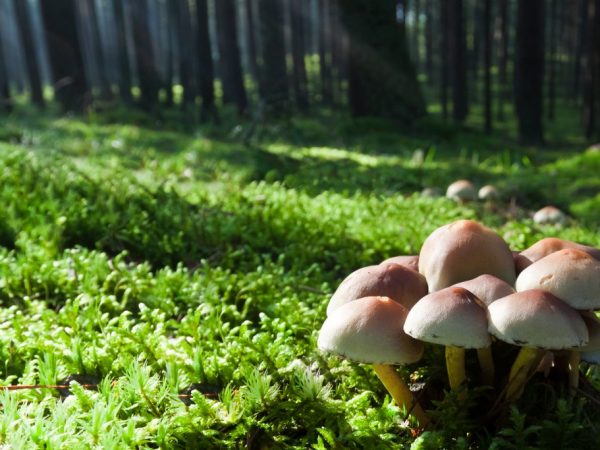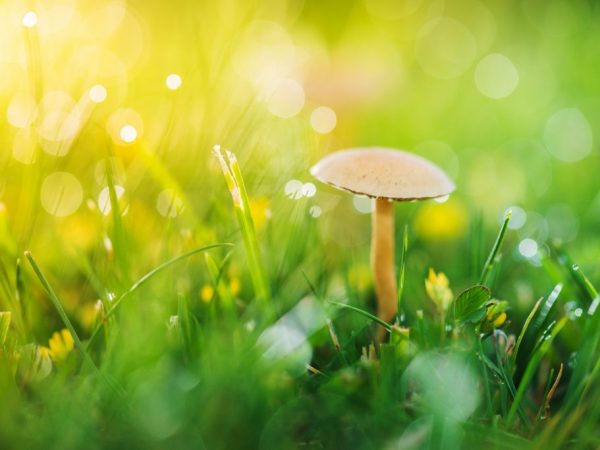Field types of mushrooms
There are mushrooms growing in open areas. Such species are common in both wooded and steppe regions. Important conditions for their growth are the presence of a favorable substrate and moisture.

Field species of mushrooms
Champignon
In English, the names of this species are associated with horses, because the species loves fertilized soil with manure. Often grows in meadow pastures, near rivers and lakes. Description:
- Hat: shape ranging from bell-shaped to flat, up to 20 cm in diameter. Color is white, cream, gradually turns yellow when touched.
- Leg: cylindrical, up to 10 cm high, with a ring. Easily detaches from the cap.
- Flesh: firm, sweet in taste, has a pronounced smell of anise or almond, turns yellow at the break.
Champignons are edible mushrooms. They are easy to distinguish from their counterparts, they are unpretentious. Suitable for all types of cooking, some even eat them raw. They grow from late May to mid-October. Sometimes they are confused with poisonous species:
- pale toadstool;
- yellow-skinned champignon.
Meadow mushrooms
Other names: nonnium, meadow, clove mushroom. These mushrooms have special properties: after a long drought, they become saturated with moisture and bear fruit again. They are undemanding to the substrate, therefore they are found in all fields. Description:
- Hat: reddish-yellow in color with a convex apex, edges are uneven, often cracked.
- Hymenophore: plates are infrequent, large, free in old mushrooms. Their color is slightly paler than the cap.
- Leg: long, thin, there is a mealy bloom. May taper downward.
- Flesh: white-yellow, has a clove or almond scent.
The fruiting season is from May to October. In cooking, only hats are usually used, because the legs are particularly stiff.
Irina Selyutina (Biologist):
Meadow honey fungus, or marasmius meadow, belongs to the 4th category of edibility and is a conditionally edible mushroom. However, despite such a definition of the place for him by a person, this species of honey agaric has anti-fungal properties and is capable of eliminating viruses and cells of malignant neoplasms. Plus, its compounds are able to expand blood vessels and affect the functioning of the thyroid gland.
By the way of feeding, nonnium (meadow honey) refers to saprophytes. According to the peculiarities of its appearance, we can say that its cap is characterized by hygrophane and its appearance depends on the amount of water in its cells, i.e. it is able to swell and dry out. The ability to withstand prolonged drying is associated with the presence of a sufficiently large amount of trehalose carbohydrate in the cells.
This type of honey agaric is characterized by such poisonous twins:
- whitish talker;
- kollibia les-loving.
Rowing
Edible field mushrooms most often require preliminary heat treatment. They must be boiled for 15 minutes.

Rowing is universal in preparation
The lilac-footed rower prefers alkaline soil, chooses pastures and wet fields as its habitats. During growth, it can form "witch circles" or rows. Appearance:
- Hat: up to 20 cm in diameter, pillow-shaped, dense to the touch.
- Hymenophore: lamellar, represented by yellow or cream plates.
- Stem: cylindrical, without tapering along its entire length. In adults, it is completely smooth, with a slight thickening at the base. The color is pale purple or lilac.
- Flesh: loose, has a fruity aroma, a little sweet on the palate.
The harvesting season is at the beginning of September, it does not last long. The row is subjected to all processing methods; in the marinade it turns white.
Raincoat
Unlike other species, these mushrooms prefer slightly arid habitats. They have a specific appearance:
- Fruit body: spherical, pear-shaped or clavate. Usually white in juveniles or brown in adult specimens. The surface of some species is covered with small formations that look like thorns.
- Shell: two-layer, outer layer - smooth, inner - leathery.
- Gleb: whitish (in young people), has a strong pleasant smell. On the cut, the color gradually changes; in old mushrooms, gleb becomes a brown or gray powder from spores.
Fruiting from mid-summer to late autumn. Young mushrooms are mainly cooked because they are soft and have a well-pronounced pleasant taste.
Irina Selyutina (Biologist):
The fruiting body of the slicker is located and formed on dense mycelial cords. Initially white in young specimens of gleb, as the fungus matures, it changes in color and divides into chambers lined with hymenium. This is where disputes are formed. When the full ripening of the fruiting body is completed, its rupture occurs at the apex and the basidiospores spill out.
The species is susceptible to a polluted environment, therefore, the place of collection of fruit bodies is chosen carefully.
Milk mushrooms
Edible mushrooms are rare in meadows. White and black Milk mushrooms grow near the forest itself or in heavily darkened birch or coniferous groves, parks.
The names go back to the Church Slavonic language and mean "heap", because mushrooms grow in groups. Description:
- Hat: wide, flat with a recess in the middle. Thick, dense to the touch. In some species, the edge is uneven or with a short fringe.
- Hymenophore: represented by often located white plates with a yellowish tinge.
- Stem: fuses with the plates, short and wide. The color is the same as that of the cap, it is hollow on the cut, the shape is cylindrical.
- Pulp: has a fruity smell in milk mushrooms, changes color at a break. It produces white milky juice, which turns yellow in air.
The fruiting season is July-September. The species is considered conditionally edible, therefore, preliminary heat treatment is recommended. Good for pickling and pickling, it becomes tough when roasted and boiled.
Conclusion
There are few field types of mushrooms. Meadow mushroom and champignon are considered delicacies. Milk mushrooms, raincoats and ryadovka are less common, their taste is much lower. All types of mushrooms found in open areas prefer saturated and moist soil, often grow on pastures and livestock areas.



